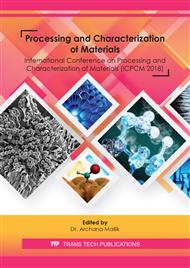p.191
p.202
p.209
p.216
p.222
p.229
p.237
p.245
p.250
Analysis of Erosion Wear Behavior of LD Sludge Filled Polypropylene Composites Using RSM
Abstract:
In the current investigation, a large number of experimental data are created for a set of Linz-Donawitz (LD) sludge filled polypropylene composites by fabricating them through compression molding technique and by conducting different tests to find out their physical, mechanical and erosion wear behaviour under controlled laboratory conditions. The erosion wear trials are carried out on the fabricated polypropylene-LD sludge composite samples as per ASTM standard using response surface methodology (RSM). This study discloses that the impact velocity and the filler content are the most predominant factors influencing the erosion rate of the composite. Mechanical characterization of the composites under this investigation reveals that the trends observed in regard to the compressive strengths are quite different from those obtained in the case of tensile strength variations with the filler loading. It is also observed that these LD sludge filled composites show improved micro-hardness and low amount of porosity.
Info:
Periodical:
Pages:
222-228
Citation:
Online since:
February 2020
Keywords:
Price:
Сopyright:
© 2020 Trans Tech Publications Ltd. All Rights Reserved
Share:
Citation:


